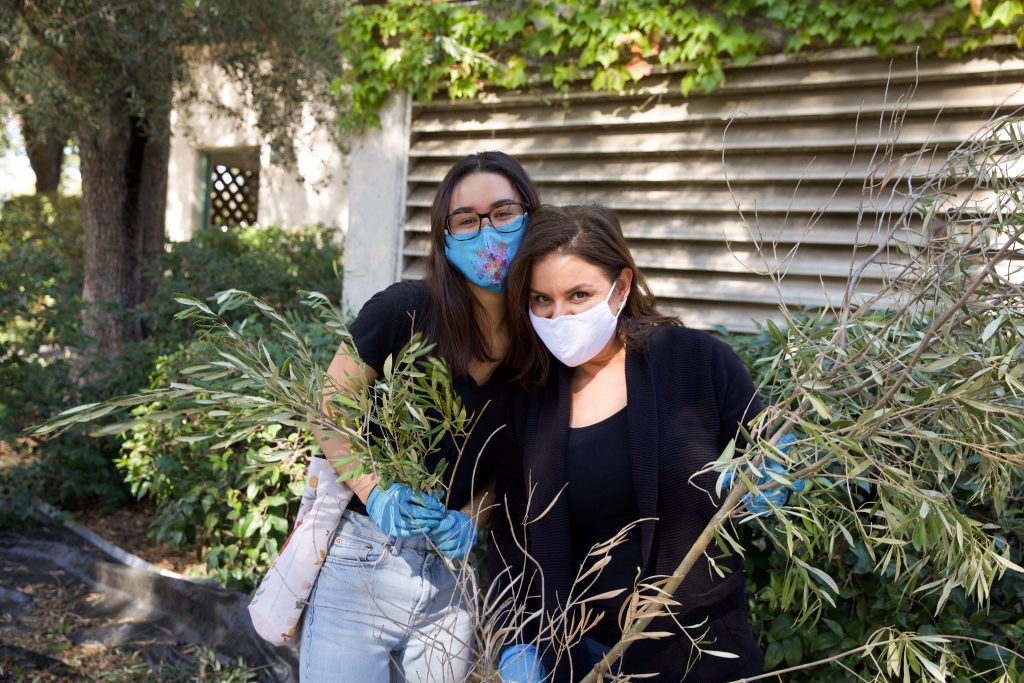Kendall Lowery ’22
Editor-in-Chief
After a two year hiatus, the Scripps Olive Harvest has returned in full force. On Nov. 5, students, professors, and administrators gathered together in the Humanities Courtyard to rustle through the olive branches, collecting the fruits that will eventually be pressed into the college’s award-winning olive oil.
Scripps College students have studied under the shade of olive trees since the school’s founding in 1926. When a campus grove faced destruction during construction in 1968, students protested, refusing to let the trees be cut down. However, even though the trees have shaped the campus landscape since its inception, they didn’t actually produce olives until 2012.
In the early aughts, students began investigating whether the plants could provide more than a shaded place to sit before classes. “They quickly found out some interesting things,” said Politics Professor Nancy Neiman. “None of the trees were actually fruiting because we had sprayed them so that they wouldn’t drop olives… because the priority was of course the aesthetics of the campus.”
Four years after the first group of students tried to initiate the olive harvest, a new group of students, Neiman, and Head of Grounds Lola Trafecanty were able to secure funding after convincing the board of trustees to allow the trees to bear fruit. By November of 2012, the Claremont community came together to harvest olives from the 85-year-old trees. Over 1,500 pounds of fruit were pressed in Ojai, creating the first batch of Scripps olive oil.
On a whim, Trafecanty drove a couple of bottles over to the Los Angeles International Extra Virgin Olive Oil Competition held at the Fairplex in Pomona, California. “It turns out that that olive oil competition is one of the five big olive oil competitions, and it just happened to be right around the corner,” said Neiman. “We entered thinking why not? And we won! We beat out the Italian olive oils, we beat out the Greek olive oils, it was really kind of cool.”
In the following years, the Scripps oil continued to medal at the Los Angeles International Extra Virgin Olive Oil Competition and the revenue created from selling the bottles funded grants for student-led sustainability projects. And despite the board of trustees’s concerns with campus aesthetics, by the time mid-October rolls around, the pathways around campus are covered in black splotches. As the temperature drops, so do the olives, making it nearly impossible to avoid the squelch of sole against seed.
Aside from accolades, grant funding, and the squashed seasonal signal that fall has arrived, the olive harvest has also produced a way for students to connect with professors, administrators, and facilities staff outside of work and academics. “I feel like we’re too in our brains on this campus,” said Sophie Perry ’22. “It’s really important to still feel connected to both external community and the landscape outside of your body.”
Olive trees are resistant to drought, disease, and fire, making them some of the hardiest plants around. However, in order for the olives to survive in Claremont’s arid climate, they still require plenty of supplemental water and attentive care from our facilities staff.
“There’s a huge commitment from the groundskeepers,” said Landscape Operations Manager Joya Salas. “It’s the fruits of their labor.”
The statewide drought that has persisted since the summer of 2020 has made caring for the trees particularly challenging this year. As of Nov. 2 2021, the US Drought Monitor reported that 93.81 percent of Californian landmass was experiencing severe drought.
“Sometimes there are things like the heat that are hard for us to avoid, but we always try to do the best for every tree,” said Groundskeeper Ramon Estrada. “In years before, I remember that we picked almost all day long… this year, I think there’s probably not even half of what we usually pick… I’ve been here 18 years already, since we had the first harvest — some years are better than others.”
As students returned to campus this year, so have the fruits of our olive trees. However, many of us return to California with renewed questions about our campus’s impact on local resources, scarce water, and the safety of ourselves and our neighbors. Now that we’re back in Claremont, the very least that we can do is to use our resources to foster community and fund sustainable practices.
“One of the ways that people really find meaning in life and connection with others is to be involved in something where you can see you’re all contributing to the same worthwhile end,” said Neiman. “When there is something tangible that results from it, I think it does bring people together.”
Scripps Olive Oil will be available for purchase in early December and more information about the student sustainability grants will be available by the end of the semester. You can get involved with the Scripps Student Garden by messaging @scrippsstudentgarden on Instagram or by attending their weekly Friday meetings from 9 to 10 a.m.
Image Source: Scripps College



